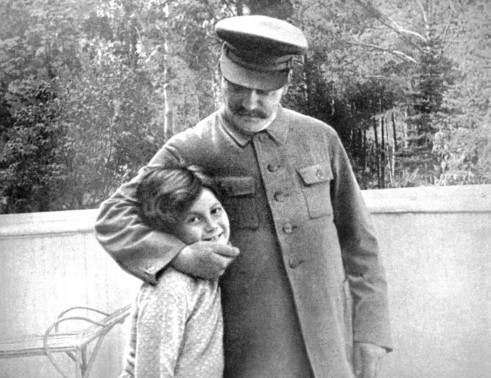
Stalin’s Daughter
By Rosemary Sullivan, Harper, 768 pages, $35
Rosemary Sullivan begins this harrowing biography with a question: “What would it mean to be born Stalin’s daughter?” And, 539 pages later, Svetlana Stalina herself provides the answer. If you are Stalin’s daughter, “you are already dead. Your life is already finished. You can’t live your own life. You can’t live any life. You live only in reference to a name.”
But Svetlana — whose name, when she died in Wisconsin in 2011, had become Lana Peters — lived a vast, long and exhausting life in which she did daily battle with the ghost of her father. Her experiences, even before she became the world’s most famous Russian dissident, were singular.
Born in 1926 when the revolution was in its youth, Svetlana was raised in the corridors of the Kremlin; secret police lurked in the kitchen, in the cupboards, even in her classroom. Stalin, worshipped by the country as a genius among mortals, loved his daughter, Khrushchev later said, “like a cat loves a mouse”.
When Svetlana was six, her mother, Nadezhda Alliluyeva, committed suicide; soon afterwards, Svetlana’s uncles and aunts were executed in the purges of the Great Terror. One of her beloved brothers then disappeared, while another was killed by the Nazis.
She remained a committed communist until she was 16 and Stalin sent her first love, 38-year-old Aleksei Kapler, to the Gulag for 10 years. Kapler remembered the teenage Svetlana as an “appallingly lonely” girl with a yearning for freedom. These aspects of her character would never change.
Svetlana said that the second half of her life began when her mother died in 1932. But her life, as Sullivan shows, was not divided into two neat parts: it was lived as a series of endlessly repeated, suffocating cycles. Aged 17, Svetlana married a student called Morozov. “He was sweet. I was lonely, and he loved me,” she recalled. He was also Jewish, and Stalin, deeply anti-Semitic, refused to meet him.
The marriage, which lasted for three years, produced a baby boy. Her second, equally short-lived marriage, to Yuri Zhdanov, the son of Stalin’s right-hand man, produced a girl. Impulsive and romantic, Svetlana’s relationships always began in the fast lane and ended in disillusion. “My life can only wind itself around somebody,” she realised, but she was never able to achieve the intimacy she yearned for.
One of her lovers, the Jewish poet David Samilov, described her as “a slave to her passions”, adding that “inside a slave, a tyrant always dwells”. He had never, said Samilov, been as “shaken and captured by the tragedy” of another as he was by that of Svetlana. And he had never “had such an intense need to run from a person”.
“Stalin’s Daughter” is filled to the rafters with similar first-hand accounts, taken from hoards of letters, interviews, articles and previously unseen papers, of Svetlana’s life, times and personality, giving the book the feel of a well-made documentary. This material is presented with a plainness bordering on understatement.
“It was all very sad,” Sullivan says of a situation the rest of us would find unendurable. When Stalin died in 1953, Svetlana described her heart as “breaking from grief and love”, and she blamed herself, as we tend to do, for not having been a better child. Her grief and love were contaminated, however, by the realisation that “everything that had taken place, not only in our family but all over the country” had been done by her father.
The “metallic” sound of his name “lacerated her heart”, and she now called herself Svetlana Alliluyeva. Under this new identity she tried, and failed, to forge a life for herself in Khrushchev’s Russia. Her third “husband” — they were not allowed to marry — was a gentle Indian communist called Brajesh Singh, who died soon after he and Svetlana met.
Granted permission to scatter his ashes in the Ganges, Svetlana, aged 41, left the Soviet Union for the first time. Acting on impulse, rather than return home to her children, Svetlana presented herself at the American Embassy in New Delhi and requested asylum; secreted in Brajesh’s empty urn was the manuscript of her book, “Twenty Letters to a Friend”.
Described by Sullivan as less a memoir than “an exorcism”, “Twenty Letters to a Friend” sold for $1.5 million (Dh5.5 million). Having entered the free world, Stalin’s daughter was instantly living the American dream. Bewildered by money — she had never before had a bank account — she distributed her riches to good causes, and signed any document put in front of her.
Inevitably, she fell in love again, this time with Wesley Peters, a creepy acolyte of the architect Frank Lloyd Wright, whose long-dead first wife had also been called Svetlana. Wes Peters was part of the Taliesin Fellowship, a cultish experiment in communal living based in the Arizona desert, presided over by Wright’s serpentine widow, Olgivanna, a personality as terrifying as Stalin himself.
The courtship between Svetlana and Wes, orchestrated by Olgivanna, lasted three weeks, and the marriage itself lasted 20 months, during which time Olgivanna and Peters garnered what was left of Svetlana’s earnings. The only benefit to come out of this wretched union was her third child, Olga, born when Svetlana was 45.
By this point in the book, we feel locked into a plot as subterranean and relentless as that of a Hitchcock film. Svetlana did not find freedom in America. Instead she experienced financial exploitation and endless press intrusion, added to which she was prevented from having contact with the children she had left behind.
In 1984 she returned to Moscow to unite Olga with her siblings, but the visit was a disaster. Back Svetlana went to America, tail between her legs. She remained estranged from her Russian children for the rest of her life.
Thus Svetlana lived like a fugitive, fleeing from place to place, looking constantly over her shoulder, falling out violently with friends, falling in love with the wrong people. She moved more than 30 times in her final years, turning up in places such as Essex, the Cornish coast, and social housing on Ladbroke Grove.
She saw herself as passive, a pawn on the world stage, but this was not how others saw Svetlana, or how Sullivan sees her. For the historian Robert Tucker, Svetlana was “in some sense, like her father”. And in some sense she was: Svetlana was the Kremlin princess who demanded her own way. But what is striking, says Sullivan, is how unlike Stalin his daughter turned out to be.
Where Stalin was inhuman, Svetlana was utterly human. Painfully naive, she was also possessive, imperious and controlling: her temper was legendary. Damaged herself, she was drawn to damaged people; raised to idealise one man, she was never able to see the reality of the many other men she loved.
It takes a fine biographer to catch a woman as parti-coloured as this, and Sullivan has produced a delicate, balanced and unforgettably good portrait of a courageous and magnificent woman.
–The Telegraph Group Limited, London 2015









